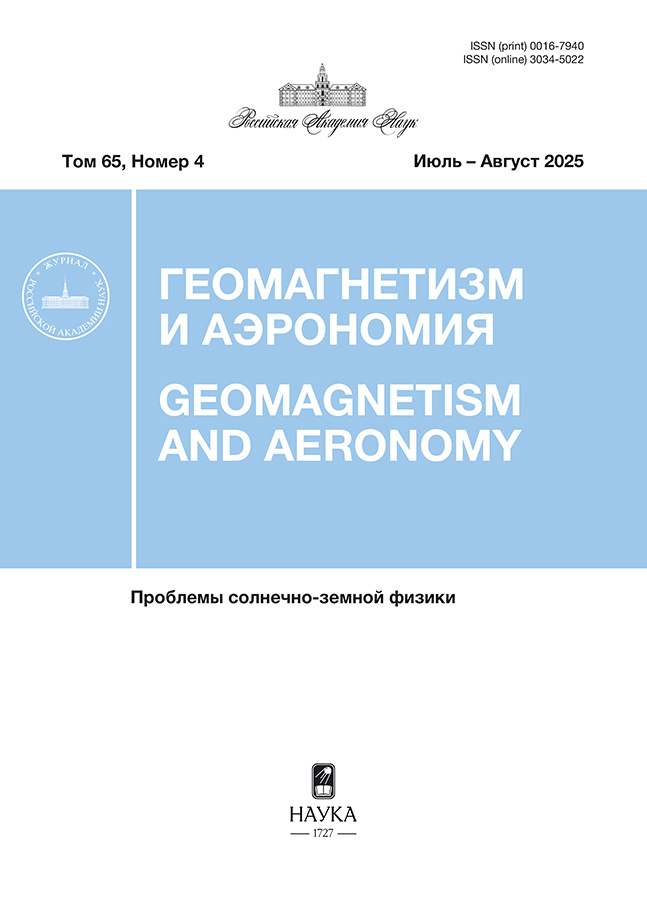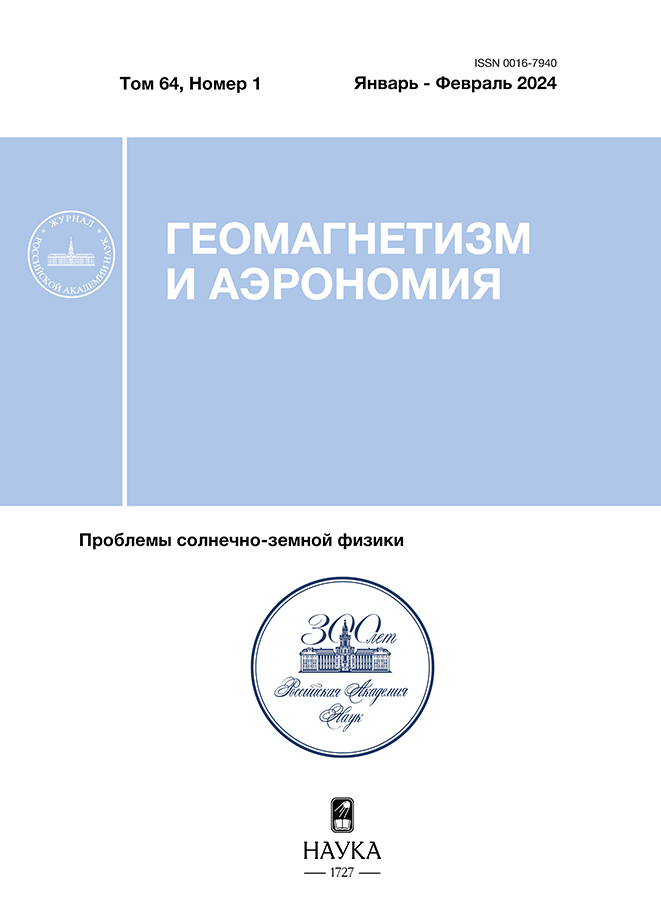Scenario for the formation of vortexlike structures in a presubstorm arc, taking into account changes in the arc height during its evolution
- Authors: Safargaleev V.V.1,2, Sergienko T.I.3, Kotikov A.L.1,4, Safargaleev A.V.5
-
Affiliations:
- Pushkov Institute of Terrestrial Magnetism, Ionosphere, and Radio Wave Propagation, Russian Academy of Sciences
- Polar Geophysical Institute, Russian Academy of Sciences
- Swedish Institute of Space Physics
- Geophysical Center, Russian Academy of Sciences
- LSR Management Company
- Issue: Vol 64, No 1 (2024)
- Pages: 74-92
- Section: Articles
- URL: https://ruspoj.com/0016-7940/article/view/650958
- DOI: https://doi.org/10.31857/S0016794024010087
- EDN: https://elibrary.ru/GQMOUV
- ID: 650958
Cite item
Abstract
Activity in a prebreakup auroral arc in the form of vortexlike structures, the appearance/disappearance of which is preceded by an increase/decrease in the brightness of the arc, was studied in the context of a magnetospheric substorm, large-scale ionospheric convection, the situation in the interplanetary medium, and triangulation measurements of the arc height. The structures are observed in the premidnight hours and represent a superposition of two auroral forms: a large-scale bend in the arc that outlines the polar boundary of the diffuse auroras and smaller luminous tongues of luminosity (mini-torches) elongated along the convection on the western slope of the bends. The structures as a whole move against convection, towards substorm activity to the east of the observation area. We attribute the appearance of structures to the propagation of a disturbance deep into the magnetosphere, generated as a result of interaction of the magnetopause with a solar wind inhomogeneity, on the front of which Bz turns southward. The results of triangulation measurements show that the increase in brightness in the prebreakup arc shortly before the appearance of vortexlike structures is accompanied by a decrease in the height of the lower edge of the arc, which we explain by the appearance of a parallel electric field above the arc, which accelerates the precipitating electrons. The role of such a field in the formation of the torchlike structures is discussed in the framework of the interchange instability of the pole boundary of diffuse auroras.
Keywords
Full Text
About the authors
V. V. Safargaleev
Pushkov Institute of Terrestrial Magnetism, Ionosphere, and Radio Wave Propagation, Russian Academy of Sciences; Polar Geophysical Institute, Russian Academy of Sciences
Author for correspondence.
Email: Vladimir.safargaleev@pgia.ru
St. Petersburg Department
Russian Federation, St. Petersburg; Murmansk region, ApatityT. I. Sergienko
Swedish Institute of Space Physics
Email: Vladimir.safargaleev@pgia.ru
Sweden, Kiruna
A. L. Kotikov
Pushkov Institute of Terrestrial Magnetism, Ionosphere, and Radio Wave Propagation, Russian Academy of Sciences; Geophysical Center, Russian Academy of Sciences
Email: Vladimir.safargaleev@pgia.ru
St. Petersburg Department
Russian Federation, St. Petersburg; MoscowA. V. Safargaleev
LSR Management Company
Email: Vladimir.safargaleev@pgia.ru
Russian Federation, St. Petersburg
References
- Волков М.А., Мальцев Ю.П. Желобковая неустойчивость внутренней границы плазменного слоя // Геомагнетизм и аэрономия. T. 26. C. 793—801. 1986.
- Галеев А.А., Сагдеев Р.З. Токовые неустойчивости и аномальное сопротивление плазмы // Основы физики плазмы. В двух томах. Дополнение к второму тому. Ред. А.А. Галеев и Р. Судан. М.: Энергоатомиздат, С. 5—37, 1984.
- Клейменова Н.Г., Антонова Е.Е., Козырева О.В., Малышева Л.М., Корнилова Т.А., Корнилов И.А. Волновая структура магнитных суббурь в полярных широтах // Геомагнетизм и аэрономия. Т. 52. № 6. С. 785—793. 2012. doi: 10.1134/S0016793212060059
- Мазур Н.Г., Федоров Е.Н., Пилипенко В.А. Трансформация БМЗ волн в альфвеновские в гиротропной продольно-неоднородной плазме // Физика плазмы. Т. 33. № 6. С. 526—533. 2007.
- Сафаргалеев В.В., Митрофанов В.Н., Козловский А.Е. Комплексный анализ полярной суббури по данным магнитных, оптических и радарных наблюдений в окрестности Шпицбергена // Геомагнетизм и аэрономия. Т. 58. № 6. С. 828—844. 2018. doi: 10.1134/S0016793218040151
- Akasofu S.-I., Kimball D.S. The dynamics of the aurora—I: Instabilities of the aurora // J. Atm. Terr .Phys. V. 26. № 2. P. 0—211. 1964. https://doi.org/10.1016/0021-9169(64)90147-3
- Atkinson G. Decoupling of convection in the magnetosphere from the ionosphere by parallel electric fields // AGU Fall Meeting 2001, abstract No SM51A-0784, AGU. 2001.
- Davis T.N., Hallinan, T.J. Auroral Spirals 1. Observations // J. Geophys. Res. V. 81. № 22. P. 3953—3958. 1976. https://doi.org/10.1029/JA081i022p03953
- Golovchanskaya I., Kornilov I., Kornilova T. East-west type precursor activity prior to the auroral onset: Ground-based and THEMIS observations // J. Geophys. Res. V. 120. № 2. P. 1109—1123. 2015. https://doi.org/10.1002/2014JA020081
- Gussenhoven M.S., Hardy D.A., Heinemann N. Systematics of the equatorward diffuse auroral boundary // J. Geophys. Res. V. 88. № 7. P. 5692—5708. 1983. https://doi.org/10.1029/JA088iA07p05692
- Gustavsson B. Tomographic inversion for ALIS noise and resolution // J. Geophys. Res. V. 103. № 11. P. 26621—26632. 1998. https://doi.org/10.1029/98JA00678
- Haerendel G. and Frey H. The onset of a substorm and the mating instability // J. Geophys. Res. V. 126. e2021JA029492.2021. https://doi.org/10.1029/2021JA029492
- Hallinan T.J., Davis T.N. Small-scale auroral arc distortions // Planet. Space Sci. V. 18. № 12. P. 1735—1744. 1970. https://doi.org/10.1016/0032-0633(70)90007-3
- Johnstone A.D. Pulsating aurora // Nature. V. 274. № 5667. P. 119—126. 1978. doi: 10.1038/274119a0
- Kalmoni N.M.E., Rae I.J., Murphy K.R., C. Forsyth C., Watt C.E.J., Owen C.J. Statistical azimuthal structuring of the substorm onset arc: Implications for the onset mechanism // Geophys. Res. Lett. V. 44. № 5. P. 2078—2087. 2017. https://doi.org/10.1002/2016GL071826
- Keiling A., Angelopoulos V., Weygand J.M., et al. THEMIS ground-space observations during the development of auroral spirals // Ann. Geophys. V. 27. № 11. P. 4317—4332. 2009. doi: 10.5194/angeo-27-4317-2009
- Keiling A., Shiokawa K., Uritsky V., et al. Auroral signatures of the dynamic plasma sheet. In: Keiling A. et al. (eds): Auroral Phenomenology and Magnetospheric Processes: Earth and Other Planets. Geophys. Monograph. Series. V. 197. P. 317—336. American Geophysical Union, Washington, D.C. 2012. https://doi.org/10.1029/2012GM001231
- Kozlovsky A., Aikio A., Turunen T., Nilsson H., Sergienko T., Safargaleev V., Kauristie K. Dynamics and electric currents of morningside Sun-aligned auroral arcs // J. Geophys. Res. V. 112. № 6. A063061of12. 2007. https://doi.org/10.1029/2006JA012244
- Li B., Marklund G., Karlsson T., et al. Inverted-V and low-energy broadband electron acceleration features of multiple auroras within a large-scale surge // J. Geophys. Res. V. 118. № 9. P. 5543—5552. 2013. https://doi.org/10.1002/jgra.50517
- Lyons L.R., Nishimura Y., Liu J., Bristow W.A., Zou Y., Donovan E.F. Verification of substormonset from intruding flow channels with high-resolution SuperDARN radar flow maps // J. Geophys. Res. V. 127. e2022JA030723. 2022. https://doi.org/10.1029/2022JA030723
- Maltsev Yu.P., Leontyev S.V., Lyatsky W.B. Pi-2 pulsations as a result of evolution of an Alfven impulse originating in the ionosphere during a brightening of aurora // Planet. Space Sci. V. 22. P. 1519—1533. 1974. doi: 10.1016/0032-0633(74)90017-8
- Motoba T., Ohtani S., Anderson B.J., Korth H., Mitchell D., Lanzerotti L.J., Shiokawa K., Connors M., Kletzing C.A., Reeves G.D. On the formation and origin of substorm growth phase/onset auroral arcs inferred from conjugate space-ground observations // J. Geophys. Res. V. 120. № 10. P. 8707—8722. 2015. https://doi.org/10.1002/2015JA021676
- Oguti T. Rotational deformations and related drift motions of auroral arcs. J. Geophys. Res. V. 79. № 25. P. 3861—3865. 1974. https://doi.org/10.1029/JA079i025p03861
- Panov E.V., Baumjohann W., Nakamura R., Pritchett P.L., Weygand J.M., Kubyshkina M.V. Ionospheric footprints of detached magnetotail interchange heads // Geophys. Res. Lett. V. 46. № 13. P. 7237—7247. 2019. https://doi.org/10.1029/2019GL083070
- Partamies N., Kauristie K., Pulkkinen T.I., Brittnacher M. Statistical study of auroral spirals // J. Geophys. Res. V. 106. № 8. P. 15415—15428. 2001. https://doi.org/10.1029/2000JA900172
- Pudovkin M.I., Steen A., Brändström U. Vorticity in the magnetospheric plasma and its signatures in aurora dynamics // Space Sci. Rev. V. 80. P. 411—444. 1997. https://doi.org/10.1023/A:1004916808514
- Rae I. J., Mann I.R., Murphy K.R. et al. Timing and localization of ionospheric signatures associated with substorm expansion phase onset // J. Geophys. Res. V. 114. № 1 A00C09. 2009. https://doi.org/10.1029/2008JA013559
- Safargaleev V., Sergienko T., Nilsson H., Kozlovsky A., Massetti S., Osipenko S., Kotikov A. Combined optical, EISCAT and magnetic observations of the omega bands/Ps6 pulsations and an auroral torch in the late morning hours: a case study // Ann. Geophys. V. 23. № 5. P. 1821—1838. 2005. doi: 10.5194/angeo-23-1821-2005
- Safargaleev V., Kozlovsky A., Honary F., Voronin A. Geomagnetic disturbances on ground associated with particle precipitation during SC // Ann. Geophys. V. 28. № 1. P. 247—265. 2010. https://doi.org/10.5194/angeo-28-247-2010
- Safargaleev V.V., Kozlovsky A.E., Mitrofanov V.M. Polar substorm on 7 December 2015: preonset phenomena and features of auroral breakup // Ann. Geophys. V. 38. № 4. P. 901—918. 2020. https://doi.org/10.5194/angeo-38-901-2020
- Safargaleev V., Sergienko T., Hosokawa K. Oyam S-I., Ogawa Y., Miyoshi Y., Kurita S., Fujii R. Altitude of pulsating arcs as inferred from tomographic measurements // Earth Planets Space. V. 74. № 1. Article id.31. 2022. https://doi.org/10.1186/s40623-022-01592-8
- Samson J.C., Cogger L.L., Pao Q. Observations of field line resonances, auroral arcs, and auroral vortex structures // J. Geophys. Res. V. 101. № 8. P. 17373—17383. 1996. https://doi.org/10.1029/96JA01086
- Sato N., Wright D.M., Carlson C.W., Ebihara Y., Sato M., Saemundsson T., Milan S., Lester M. Generation region of pulsating aurora obtained simultaneously by the FAST satellite and a Syowa-Iceland conjugate pair of observatories // J. Geophys. Res. V. 109. № 10. A10201. 2004. https://doi.org/10.1029/2004JA010419
- Shiokawa K., Nosé M., Imajo S., et al. Arase observation of the source region of auroral arcs and diffuse auroras in the inner magnetosphere // J. Geophys. Res. V. 125. № 8. Article id. e27310. 2020. https://doi.org/10.1029/2019JA027310
- Solovyev S.I., Baishev D.G., Barkova E.S., Molochushkin N.E., Yumoto K. Pi2 magnetic pulsations as response on spatio-temporal oscillations of auroral arc current system // Geophys. Res. Letters. V. 27. № 13. P. 1839—1842. 2000. https://doi.org/10.1029/2000GL000037
- Swift D. The possible relationship between the auroral breakup and the interchange instability of the ring current // Planet. Space Sci. V. 15. № 8. P. 1225—1226. 1967. doi: 10.1016/0032-0633(67)90179-1
- Trondsen T., Cogger L. A survey of small-scale spatially periodic distortions of auroral forms // J. Geophys. Res. V. 103. № 5. P. 9405—9415. 1998. https://doi.org/10.1029/98JA00619
- Voronkov I., Rankin R., Frycz P., Tikhonchuk V.T., Samson J.C. Coupling of shear flow and pressure gradient instabilities // J. Geophys. Res. V. 102. № 5. P. 9639—9650. 1997. https://doi.org/10.1029/97JA00386
- Webster H.F., Hallinan T.J. Instabilities in charge sheets and current sheets and their possible occurrence in the aurora // Radio Sci. V. 8. № 5. P. 475—482. 1975. https://doi.org/10.1029/RS008i005p00475
- Yamamoto T., Inoe S., Meng C.-I. Formation of auroral omega bands in the paired region 1 and region 2 field-aligned current system // J. Geophys. Res. V. 102. № 2. P. 2531—2544. 1997. https://doi.org/10.1029/96JA02456
- Yamamoto T. Numerical simulation for a vortex street near the poleward boundary of the nighttime auroral oval // J. Geophys. Res. V. 117. № 2. A02209. 2012. https://doi.org/10.1029/2011JA017011
Supplementary files



















